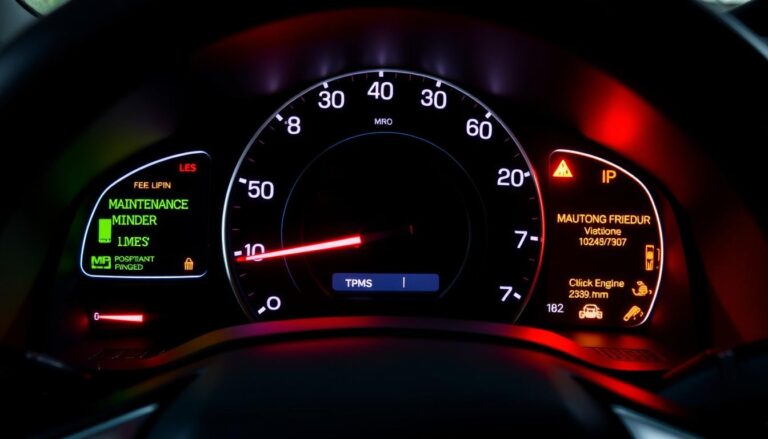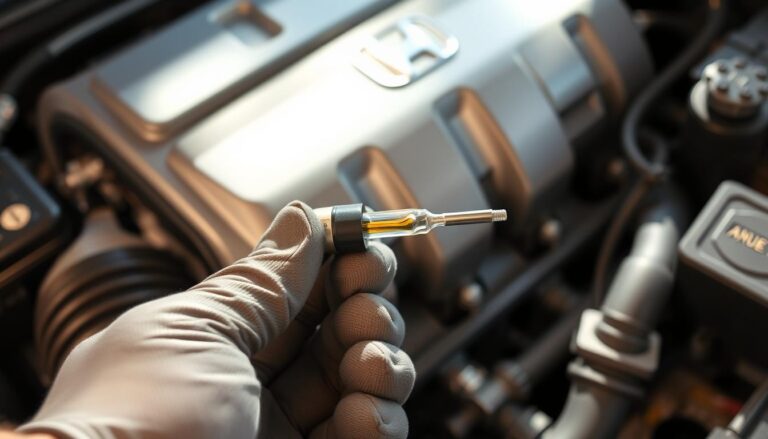The maintenance of tire pressure is paramount for the vehicular performance and safety. For those who own a Honda Accord, the regular inspection of tire pressure is pivotal. It directly influences fuel efficiency, handling, and the lifespan of the tires.
Failure to maintain the appropriate tire pressure can lead to a myriad of issues. Underinflated tires are associated with heightened fuel consumption and uneven wear patterns. On the other hand, overinflated tires compromise traction and elevate the risk of tire failure. This article aims to elucidate the straightforward process of verifying the tire pressure on your Honda Accord. It ensures adherence to the recommended pressure, thus optimizing your vehicle’s performance.
Key Takeaways
- Understand the importance of maintaining the correct tire pressure for your Honda Accord.
- Learn the steps to check tire pressure accurately.
- Discover the recommended tire pressure for your Honda Accord model.
- Find out how to adjust tire pressure according to different driving conditions.
- Recognize the benefits of regular tire pressure checks.
The Importance of Proper Tire Pressure
Adherence to the correct tire pressure is paramount for the safety, efficiency, and handling of your Honda Accord. It transcends mere recommendation, becoming a critical necessity that influences multiple facets of your vehicle’s performance.
Safety Benefits
The enhancement of safety is a primary advantage of maintaining proper tire pressure. Underinflated tires compromise traction, extend stopping distances, and elevate the risk of blowouts. By adhering to the recommended pressure, the risk of accidents due to tire failure is significantly diminished. Properly inflated tires guarantee superior handling and stability, notably at elevated speeds.
Fuel Efficiency Advantages
Correct tire pressure is also instrumental in optimizing your Honda Accord’s fuel efficiency. Underinflated tires increase rolling resistance, necessitating a heightened engine workload and, thus, increased fuel consumption. By ensuring your tires are properly inflated, you can enhance your vehicle’s fuel economy, resulting in substantial savings on fuel costs. A well-maintained tire pressure can yield considerable savings over the long term.

Extended Tire Life
Maintaining the correct tire pressure extends the lifespan of your tires. Underinflation precipitates uneven wear, necessitating premature replacement. Proper inflation ensures uniform tread wear, maximizing tire longevity. This not only reduces the financial burden of tire replacements but also guarantees consistent performance and safety.
Impact on Vehicle Handling and Performance
Proper tire pressure has a direct and significant impact on your Honda Accord’s handling and performance. Correctly inflated tires offer superior grip and responsiveness, rendering your vehicle more pleasurable to operate. Further, proper tire pressure ensures predictable handling, enhancing overall driving safety and comfort.
In conclusion, maintaining the correct tire pressure is indispensable for your Honda Accord’s safety, efficiency, and overall performance. Regularly verifying your tire pressure with a reliable tire pressure gauge is a simple yet effective measure to ensure your vehicle operates optimally.
Understanding Tire Pressure Specifications for Honda Accord
The tire pressure specifications for your Honda Accord are pivotal in determining its handling and fuel efficiency. Adherence to the correct pressure is imperative for the safety and performance of your vehicle.
Finding the Recommended PSI
To ascertain the recommended tire pressure for your Honda Accord, consult the owner’s manual or the tire information placard situated on the driver’s side doorjamb. This placard will delineate the recommended pressure in pounds per square inch (PSI) for both the front and rear tires.
Different Pressure Requirements for Front and Rear Tires
The front and rear tires of a Honda Accord typically require different recommended pressure settings. This disparity is attributed to the vehicle’s weight distribution and the manufacturer’s design specifications. Always refer to the recommended pressures listed on the tire information placard.

Variations Across Honda Accord Model Years
The recommended tire pressure can vary across different model years of the Honda Accord. It is crucial to verify the specific recommendations for your vehicle’s model year, as older models may have different requirements than newer ones.
Seasonal Pressure Adjustments
Tire pressure is influenced by seasonal temperature fluctuations. As temperatures decrease, tire pressure diminishes, and as temperatures increase, it ascends. Regularly checking your tire pressure at the commencement of each season is advisable to ensure it remains at the recommended level.
By comprehending and adhering to these tire pressure specifications, you can facilitate optimal performance, safety, and efficiency of your Honda Accord.
Essential Tools for Checking Tire Pressure
To ensure optimal tire pressure, a selection of indispensable tools is imperative. The accuracy in tire pressure assessment is paramount for safety, fuel efficiency, and the preservation of tire longevity.
Tire Pressure Gauges: Digital vs. Analog
The cornerstone of tire pressure monitoring is the tire pressure gauge. The choice between digital and analog gauges is pivotal. Digital gauges offer rapid, exact measurements, contrasting with analog gauges, which are often more economical and battery-free.
Portable Air Compressors
A portable air compressor serves as a versatile tool for inflating tires on the move. These devices are designed to be compact, drawing power from your vehicle’s 12V outlet.
Using Gas Station Air Pumps
Gas station air pumps represent a convenient alternative. They are typically precise and capable of handling elevated pressure demands.
Additional Helpful Equipment
Additional tools of utility include a tire valve cap remover and a tire pressure monitoring system (TPMS) tool for vehicles equipped with TPMS.
How to See Tire Pressure on Honda Accord Using the TPMS
Utilizing the Tire Pressure Monitoring System (TPMS) on your Honda Accord is paramount for peak vehicle performance. This system alerts you to suboptimal tire pressure, enhancing road safety and fuel efficiency. It is imperative to understand its operation for the well-being of your vehicle and yourself.
Accessing the Tire Pressure Information on the Dashboard
The method for retrieving tire pressure data through the TPMS differs across various Honda Accord model years.
For 2008-2012 Models
Accessing tire pressure information on these models involves navigating through the settings menu on your dashboard display. Initiate by pressing the “Info” button until you reach the “Tire Pressure” screen.
For 2013-2017 Models
On these models, the TPMS information is accessed via the “Menu” button on your steering wheel controls. Navigate to “Vehicle Info” and then select “Tire Pressure.”
For 2018 and Newer Models
For the most recent models, tire pressure data is accessed through the “Driver Info” menu on your dashboard. Utilize the controls on your steering wheel to navigate to “Tire Pressure Monitoring.”
Understanding the TPMS Warning Light
The TPMS warning light on your Honda Accord dashboard will illuminate if the system detects underinflated tires. Upon illumination, it is crucial to check your tire pressure immediately and adjust it according to the recommended levels indicated on the tire information placard located on the driver’s side doorjamb.
| Model Year | TPMS Access Method | Recommended Action if Warning Light Illuminates |
|---|---|---|
| 2008-2012 | Info button on dashboard | Check tire pressure and adjust |
| 2013-2017 | Menu on steering wheel controls | Check tire pressure and adjust |
| 2018+ | Driver Info menu | Check tire pressure and adjust |
Resetting the TPMS After Pressure Adjustment
Following tire pressure adjustment, resetting the TPMS may be necessary. The reset process varies by model year, but generally, it involves holding down the “TPMS” button or following the instructions in your owner’s manual.
Limitations of the TPMS System
Despite its utility, the TPMS system has limitations. It may not function correctly if the tires are not properly registered to the system or if there are issues with the sensors.
Step-by-Step Guide to Manually Checking Tire Pressure
Understanding the intricacies of manually checking tire pressure on your Honda Accord is paramount for maintaining optimal performance and safety. This task, though seemingly complex, is in reality a straightforward process that can be executed in the comfort of your own home with minimal equipment.
When to Check Your Tire Pressure
It is advisable to conduct a tire pressure check at least once a month and prior to embarking on extended journeys. The necessity for such a check is heightened when the tires are in a ‘cold’ state, a condition defined as having not been subjected to vehicular movement for a duration of at least three hours.
Preparing Your Vehicle
Position your Honda Accord on a surface that is perfectly level. Subsequently, extinguish the engine and activate the parking brake. These precautions are imperative to guarantee your safety during the tire pressure assessment process.
Removing the Valve Cap
The valve cap serves as a protective barrier against the ingress of dirt and moisture. Its removal is facilitated by unscrewing it in a counterclockwise direction.
Using the Pressure Gauge Correctly
Secure the tire pressure gauge onto the valve stem with a firm press, until a hissing sound is audible. Record the reading and compare it against the recommended pressure, which can be found on the tire information placard located on the driver’s side doorjamb or within your owner’s manual.
| Tire Position | Recommended Pressure (PSI) |
|---|---|
| Front Tires | 32 |
| Rear Tires | 30 |
Adding or Releasing Air
In the event that the pressure is found to be suboptimal, the appropriate corrective action would be to add air. Should the pressure be excessively high, the release of air is achieved by pressing the center of the valve stem. Subsequent to this, recheck the pressure with your gauge.
Confirming the Correct Pressure
Upon achieving a pressure reading that aligns with the recommended level, the valve cap should be reinstated to safeguard the valve stem.
Safety Tips During the Process
It is paramount to conduct tire pressure checks when the tires are in a ‘cold’ state. Exercise caution when handling tire pressure gauges and air compressors to prevent potential injury.
“Proper tire inflation is crucial for safety, fuel efficiency, and the longevity of your tires. Regular checks can save you money and ensure a smoother ride.”
By adhering to these guidelines, you can guarantee that your Honda Accord’s tires are at the optimal inflation level, thus enhancing both the performance and safety of your vehicle.
Maintaining Proper Tire Pressure for Your Honda Accord
Ensuring the correct tire inflation is paramount for the optimal performance and safety of your Honda Accord. As previously discussed, maintaining the correct Honda Accord tire pressure enhances fuel efficiency, extends tire life, and improves vehicle handling.
Utilizing the Tire Pressure Monitoring System (TPMS) and performing manual checks are essential to ensure your tires are always properly inflated. Regularly checking tire pressure, notably during seasonal changes, is crucial for maintaining your vehicle’s overall health.
By adhering to the steps outlined in this article, you can effortlessly check and adjust your Honda Accord’s tire pressure to the recommended levels. This simple maintenance task can significantly impact your vehicle’s performance and your safety on the road.
FAQ
What is the recommended tire pressure for my Honda Accord?
The recommended tire pressure for your Honda Accord is specified on the tire information placard located on the driver’s side doorjamb or within your owner’s manual. Variations exist based on the model year and trim level of your vehicle.
How often should I check my Honda Accord’s tire pressure?
It is advisable to verify your tire pressure at least once monthly and prior to embarking on long journeys. Seasonal changes also necessitate a tire pressure check, as temperature fluctuations can impact pressure levels.
Can I use a digital or analog tire pressure gauge to check my Honda Accord’s tire pressure?
Both digital and analog gauges are suitable for monitoring tire pressure. It is crucial to select a gauge that is both accurate and reliable. Gauges can be sourced from most auto parts stores or online.
What is the purpose of the Tire Pressure Monitoring System (TPMS) in my Honda Accord?
The TPMS is engineered to monitor your Honda Accord’s tire pressure and alert you if it falls below the recommended level. This system enhances safety, fuel efficiency, and vehicle handling.
How do I reset the TPMS on my Honda Accord after adjusting the tire pressure?
To reset the TPMS, adhere to the instructions outlined in your owner’s manual. The procedure may differ based on your vehicle’s model year. Generally, you must press and hold a dashboard button until the TPMS light blinks or turns off.
Can I check my Honda Accord’s tire pressure when the tires are hot?
It is not advisable to measure tire pressure when the tires are hot, as this can yield inaccurate readings. Optimal readings are obtained when the tires are cold, meaning the vehicle has been stationary for at least three hours.
What are the consequences of driving with underinflated tires on my Honda Accord?
Operating your Honda Accord with underinflated tires can result in decreased fuel efficiency, uneven tire wear, and an elevated risk of tire failure. It also impairs vehicle handling and performance.
How does tire pressure affect the handling and performance of my Honda Accord?
Adequate tire pressure enhances your Honda Accord’s handling and performance by ensuring optimal traction, stability, and responsiveness. Underinflated tires, conversely, compromise these attributes.


